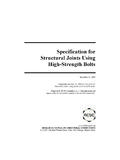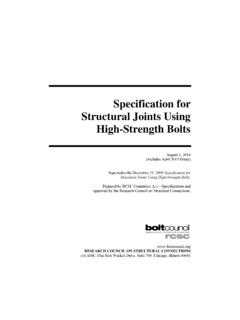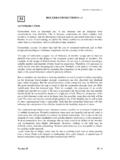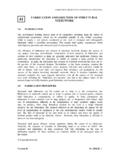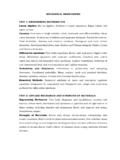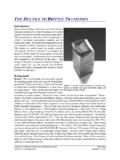Transcription of RCSC Specification Committee, Task Group 3, …
1 Page 1 RCSC Specification Committee, Task Group 3, design June 9, 2016 Holiday Inn Lafayette--City Centre, 515 South Street, Lafayette Pitman Block A 9:45 am to 10:45 am EDT Meeting Agenda 1. Welcome 2. Introductions 3. Approval of February 22 teleconference minutes (attachment 3-A) 4. Work Items a. Joint strength in slipped slip-critical connections (W. Thornton) b. Section (P. Fortney/B. Butler): provide more guidance on when slip-critical connections should be used c. Shear strength reduction in long connections (R. Tide) (attachment 3-B) d. S14-057b (attachment 3-C - snug-tightened joints) 5. Development of work items (P. Fortney) 6. New Business1/3 ATTACHMENT 3-A Task Group 3 Minutes Teleconference Meeting Remote Monday, February 22, 2016 1:00PM 2:00PM EST AGENDA 1. Welcome 2. TG 3 Roster Pat Fortney, Chair Doug Ferrell, Secretary Bruce Butler Robert Connor Peter Dusicka Jerry Hajjar Carly Pravlik Ray Tide Bill Thornton Jim Swanson In Attendance Not in Attendance Ray Tide Jim Swanson Bill Thornton Pat Fortney Carly McGee Robert Connor Peter Dusicka Bruce Butler Jerry Hajjar Doug Ferrell 2/3 3.
2 Task Group 3 Responsibility a. Section 4: Joint Type b. Section 5: Limit States in Bolted Joints c. Appendix A: Testing Method to Determine the Slip Coefficient for Coating used in Bolted Joints 4. Proposal S15-066 - Interlaboratory Variability of Slip Coefficient Testing Comments on proposed changes Ray Tide: Suggests that the document reference F3125 and that the testing is applicable with the old A anf F bolt designations. 5. Development of action/work items Task Group recommendations/suggestions Carly: pressure from coating manufacturers to get Appendix A changed and updated. Bruce would like to make this a priority. TG 3: Action Item task the TG 3 to review the document and submit comments to TG3 by March 14. TG3 will then sumbit their recommendations to the Specification committee prior to the [email?] ballot. Bill Thornton: When a slip-critical connection slips into bearing, is there any pretension left?
3 Ray Tide says that there is pretension left in the bolts after slip. Kulak assumed a complete loss to simplify their analysis. Bill suggests that we could make connection more economical if we could eliminate bearing type checks in slip critical joints. Ray suggests that a long-term research project would be required to address this issue. Bruce thinks this is a good idea, and worthwhile looking at. Rob asks exactly what we would be looking at? Bill says that if it slips into bearing, we want to quantify what slip is left and that slip resistance be considered in the design of the connection. Jim wrote a paper about the loss of pretension. He found that a full loss of pretension did not occur. TG 3 will open a work item. 3/3 Pat Fortney: Pat suggested removing article (4) of section Bruce suggested that we provide further guidance, not remove it entirely.
4 TG3 work item: Provide further guidance in regard to (4) what/when is slip detrimental. 6. Next Live Meeting Location: Purdue University, West Lafayette, IN Date: June 2016 Executive Committee Meeting: June 8 Committee Meetings: June 9 Annual Meeting: June 10 SHEAR CAPACITY OF HIGH STRENGTH BOLTS IN LONG CONNECTIONS Raymond Tide, Principal Wiss, Janney, Elstner Associates, Inc. (WJE), 330 Pfingsten Road, Northbrook, Illinois 60062 ABSTRACT Current design codes reduce the shear strength of individual bolts to account for potentially uneven distribution of force among the bolts including a / ( percent) step function at 38 in. Available test data indicate that there is no justification for a bolt shear strength reduction, especially the step function, due to the length of connection, provided that second order effects are limited and gross and net section areas slightly exceed the AISC Specification limits.
5 A practical, empirical solution is proposed that maintains a reliability, , slightly greater than , for all connection lengths using the current AISC resistance factor, , of Keywords: bolt shear, reliability, resistance factor, connection length BACKGROUND The exact solution for the load distribution in a long bolted connection was developed by Fisher (1965), reported by Kulak (1987) and Tide (2012a). Because the load-deformation relationships for the bolts and plates must be known, it is not a practical solution for design purposes. Therefore, empirical solutions have been developed for bolted connections. The current empirical shear strength of a high strength bolt, Tide (2010), may be expressed by the following equation: Pn = Pu Ab R1R2R3 (1) Where: Pu = ultimate tensile strength of bolt (ksi) R1 = , shear-to-tension ratio R2 = , initial connection length reduction factor for L 38 in.
6 = , connection length reduction factor for L > 38 in. R3 = , threads excluded from shear plane = , threads included in shear plane L = connection length between end bolt center lines (in.) Ab = nominal bolt area (in2) The design shear values for ASTM A325 and A490 bolts are given in RCSC Specification Table (RCSC, 2014). The design values, for other fasteners, such as ASTM A307 bolts and threaded material, are given 2 in AISC Specification for Structural Steel Buildings (hereafter AISC (2010) Specification ), Table In Load Resistance and Factor design (LRFD) terms, the design shear strength of a bolt is Rn, with = and Rn = Pn. A step function with an percent reduction exists at connection length equal to 38 in. The design values are based on an extensive research program conducted by the steel industry at the Fritz Engineering Laboratory at Lehigh University from the 1950s through the early 1970s.
7 As was the custom at the time, the high-strength bolts were fully pre-tensioned and bolt threads were excluded from the shear plane. The test data was previously reported by Tide (2010, 2012a) in customary units and in dimensional units, respectively. The data is summarized in the Guide to design Criteria of Bolted and Riveted Joints (the Guide) by Kulak et al. (1987), and will not be repeated in this paper. The test data has also been used to evaluate and compare the bolt shear provisions of the Australian Code, Tide (2012b), and the Eurocode provisions as found in Comite Europeen de Normalization (CEN) (2003) , Tide (2012a, 2014). Because the Canadian provisions (CSA) (2001, 2005) are similar to the Eurocode criteria, all of these provisions utilize a variable bolt diameter dependent connection length factor instead of a step function, including an increase in unit strength with increasing bolt diameter.
8 CONNECTION TEST VARIABLES All of the connections considered by Tide (2010) and in the Guide (Kulak 1987) were loaded uniaxially eliminating second order effects, the bolts were pretensioned, and the threads excluded from the shear plane. Moore (2010) recommended a resistance factor, , of , based on the results of approximately 1,500 tests that indicated theoretical resistance factors of and produce a reliability of 4 for the threads excluded and threads included conditions, respectively. This can be compared to the AISC resistance factor of Empirical data indicate that bolts will be subjected to nearly uniform shear when designs comply with current Specification limit states. Bendigo (1963) states: But, experimental work with riveted connections9 has shown that successive yielding of the outer rivets produces a redistribution of load so that at failure a more uniform distribution exists than the elastic analysis indicates.
9 Reference 9 is the work presented by Davis (1940). The Guide (Kulak 1987), Section , pages 103 and 104, indicate that nearly equal load distribution occurs when the ratio of the plate net section to the connector shear area is large. This was confirmed by the author when the referenced papers were reviewed relative to the connection failures in long connections. TEST DATA Tide (2010) compiled test data from 10 papers and reports: Bendigo et al. (1963), Fisher et al. (1963), Fisher and Kulak (1968), Fisher and Yoshida (1970), Foreman and Rumpf (1961), Kulak and Fisher (1968), Power and Fisher (1972), Rivera and Fisher (1970), and Sterling and Fisher (1965, 1966). Because of the various reporting formats and test parameters, the results were not directly comparable. Instead, the published test ultimate shear strength of each connection was reduced to an average ultimate shear strength, PTEST, of a single connector, bolt or rivet, loaded on two shear planes (double shear).
10 The predicted ultimate shear strength of the same 3 connector was computed using appropriate single shear connector test data multiplied by two, PPRED, for each lot of bolts or rivets. The ratio PTEST/PPRED was then computed, and entered into a database, to compare the results, with connection length as the only independent variable. Tide (2010, 2012a) presents the results, which are not repeated here. Though Tide included test results for Huck bolts and rivets, these fasteners are not considered in this paper. The test data was then plotted as shown in Figure 1 after being conditioned according to the AISC (2010) specifications limit states of connection gross area and net area requirements, respectively. The specifications limit states were modified by a factor of Development of this criteria is found in Tide (2010, 2012a).
